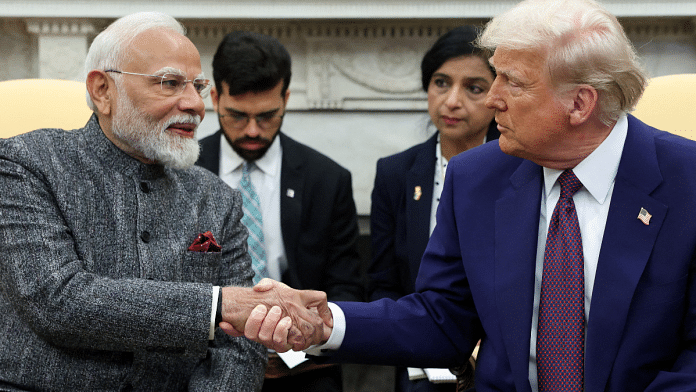With one stroke of his pen, US President Donald Trump has dented India’s ambition to be the world’s ‘China Plus One’ manufacturing hub. His decision to levy a tariff of 25 per cent—plus an unspecified penalty for buying Russian arms and crude oil—on India’s exports to the US will have real consequences. America is, after all, the world’s largest economy and biggest consumer of all goods.
Indian exporters will face a higher tariff than East Asian countries like Vietnam (20 per cent), the Philippines (19 per cent), and Indonesia (19 per cent). Penalty included, the levy will end up closer to Bangladesh, which faces a 35 per cent rate. Remember, countries like Vietnam already have a cost advantage over India.
So, how did we end up in this position? And can we change it? The good news is that Trump’s decisions aren’t always set in stone. The bad news is that the Indian economy has several chronic structural weaknesses, which weigh us down while negotiating.
Stuck playing defence
Perhaps it was always over-optimistic to hope for a trade deal that would meet expectations on both sides. For long, Trump has singled India out as an egregious offender on trade barriers, both tariff and non-tariff. And he isn’t wrong. Countries in East Asia, like China and Vietnam, haven’t been as tariff-happy and have used other methods of supporting domestic producers, such as subsidies. India’s expectation would always have been for a “friendly” deal. It probably expected a staggered reduction of tariffs over a decade or more, exclusion of the most sensitive sectors like dairy and farming, and a lower average tariff from the US than from India (because India is a lower–middle income economy and a counterweight to China).
However, President Trump is a tough negotiator and wants to show results to his electors here and now. The US would have wanted a much greater upfront tariff reduction (than the UK did); it would have wanted market access for its agricultural exports; and it would have wanted India not to buy Russian oil and arms.
But all of these are only the proximate causes of Trump’s India tariff announcement, a day ahead of the 31 July deadline for a trade deal. The reality is that Indian negotiators aren’t always on the strongest footing in most negotiations. They tend to play defence rather than strategic offence. And that is because two out of the three pillars of the Indian economy—agriculture and industry—are not ready to face unbridled external competition. In turn, that is because the country hasn’t implemented the depth of market reforms required to be a truly competitive economy.
Consider the reality that India will never be able to have flexibility while negotiating on agriculture. It would be suicidal for any government to open up the sector to external competition when the largest part of the sector is low–productivity subsistence agriculture. More than half the population still relies on farming. Agriculture has remained untouched by market reform. The Modi government tried to modernise the sector, but it didn’t succeed in facing down large farmer lobbies. For the foreseeable future, agricultural reform seems off the policy agenda.
Also read: India must not retaliate to Trump’s tariff tactic. Secure interim deal, fix internal issues
A lesson long overdue
By now, almost 35 years after the 1991 market reforms, India should have been able to at least create a competitive manufacturing sector. That would have greatly eased the burden of agriculture by absorbing surplus labour, offering high–productivity jobs. But the absence of fundamental reforms has proved to be an Achilles’ heel.
Factor markets—land, labour, and capital—are still highly controlled and regulated, which has kept costs elevated. Power is expensive, and industry is charged higher rates to cross-subsidise consumers and farmers. Railway tariffs are too high because freight charges cross-subsidise passengers. Clearances for projects take years. The one reform that did happen after 1991 was trade liberalisation, but that was reversed after 2014 in an attempt to give manufacturing another chance.
Unfortunately, tariff protection alone cannot create a globally competitive manufacturing. It can, at best, be a temporary crutch while other reforms are implemented. India is now caught in an awkward position where tariffs are higher than what the initial post-1991 trajectory would have suggested, while other reforms haven’t taken off. It’s a self-inflicted double wound.
India cannot and should not bow to America’s terms. Every country has to protect its immediate interests. But the Trump tariffs will hopefully bring the long-overdue realisation that it is unwise to expect any favours from the world in our quest for prosperity. The hard work has to be done at home. Whether or not a better deal can be negotiated with the US, there is no escape from the need to create a truly competitive economy.
Dhiraj Nayyar is Chief Economist at Vedanta. His X handle is @nayyardhiraj. Views are personal.
(Edited by Prasanna Bachchhav)






